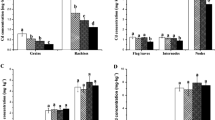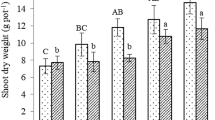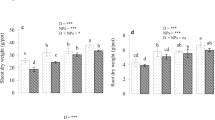Abstract
Nanofertilizers may be more effective than regular fertilizers in improving plant nutrition, enhancing nutrition use efficiency, and protecting plants from environmental stress. A hydroponic pot experiment was conducted to study the role of foliar application with 2.5 mM nano-silicon in alleviating Cd stress in rice seedlings (Oryza sativa L. cv Youyou 128) grown in solution added with or without 20 μM CdCl2. The results showed that Cd treatment decreased the growth and the contents of Mg, Fe, Zn, chlorophyll a, and glutathione (GSH), accompanied by a significant increase in Cd accumulation. However, foliar application with nano-Si improved the growth, Mg, Fe, and Zn nutrition, and the contents of chlorophyll a of the rice seedlings under Cd stress and decreased Cd accumulation and translocation of Cd from root to shoot. Cd treatment produced oxidative stress to rice seedlings indicated by a higher lipid peroxidation level (as malondialdehyde (MDA)) and higher activities of antioxidant enzymes such as superoxide dismutase (SOD), peroxidase (POD), and catalase (CAT), and a lower GSH content. However, those nano-Si-treated plants had lower MDA but higher GSH content and different antioxidant enzyme activities, indicating a higher Cd tolerance in them. The results suggested that nano-Si application alleviated Cd toxicity in rice by decreasing Cd accumulation, Cd partitioning in shoot and MDA level and by increasing content of some mineral elements (Mg, Fe, and Zn) and antioxidant capacity.







Similar content being viewed by others
References
Aebi H (1984) Catalase in vitro. Methods Enzymol 105:121–126
Alcántara E, Romera FJ, Cañete M, Manuel D (1994) Effects of heavy metals on both induction and function of root Fe(III) reductase in Fe-deficient cucumber (Cucumis sativus L.) plants. J Exp Bot 45:1893–1898
Ali S, Farooq MA, Yasmeen T, Hussain S, Arif MS, Abbas F, Bharwana SA, Zhang G (2012) The influence of silicon on barley growth, photosynthesis and ultra-structure under chromium stress. Ecotoxicol Environ Saf 89:66–72
Arnon DI (1949) Copper enzymes in isolated chloroplasts. Polyphenoloxidase in Beta vulgaris. Plant Physiol 24:1–15
Chaney RL, Reeves PG, Ryan JA, Simmons RW, Welch RM, Angle JS (2004) An improved understanding of soil Cd risk to humans and low cost methods to phytoextract Cd from contaminated soils to prevent soil Cd risks. Biometals 17:549–553
Chen H, Zheng C, Tu C, Zhu Y (1999) Heavy metal pollution in soils in China: status and countermeasures. Ambio 28:130–134
da Cunha KPV, do Nascimento CWA (2009) Silicon effects on metal tolerance and structural changes in maize (Zea mays L.) grown on a cadmium and zinc enriched soil. Water Air Soil Pollut 197:323–330
De Vos CR, Vonk MJ, Vooijs R, Schat H (1992) Glutathione depletion due to copper-induced phytochelatin synthesis causes oxidative stress in Silene cucubalus. Plant Physiol 98:853–858
Epstein E (1999) Silicon. Annu Rev Plant Biol 50:641–664
Giannopolitis CN, Ries SK (1977) Superoxide dismutases I. Occurrence in higher plants. Plant Physiol 59:309–314
Gong W, Pan G (2006) Issues of grain Cd uptake and the potential health risk of rice production sector of China. Sci Technol Rev 24:43–48 (in Chinese)
Griffith OW (1980) Determination of glutathione and glutathione disulfide using glutathione reductase and 2-vinylpyridine. Analyt Biochem 106:207–212
Hawksworth D (1985) Rice diseases. CMI Slough, CAB, UK
Horst WJ, Fecht M, Naumann A, Wissemeier AH, Maier P (1999) Physiology of manganese toxicity and tolerance in Vigna unguiculata (L.) Walp. J Plant Nutr Soil Sci 162:263–274
Iwasaki K, Maier P, Fecht M, Horst WJ (2002) Effects of silicon supply on apoplastic manganese concentrations in leaves and their relation to manganese tolerance in cowpea (Vigna unguiculata (L.) Walp.). Plant Soil 238:281–288
Khandekar S, Leisner S (2011) Soluble silicon modulates expression of Arabidopsis thaliana genes involved in copper stress. J Plant Physiol 168:699–705
Liang Y, Chen Q, Liu Q, Zhang W, Ding R (2003) Exogenous silicon (Si) increases antioxidant enzyme activity and reduces lipid peroxidation in roots of salt-stressed barley (Hordeum vulgare L.). J Plant Physiol 160:1157–1164
Liang Y, Sun W, Zhu Y-G, Christie P (2007) Mechanisms of silicon-mediated alleviation of abiotic stresses in higher plants: a review. Environ Pollut 147:422–428
Liu W, Yang Y, Zhou Q, Xie L, Pa L, Sun T (2007) Impact assessment of cadmium contamination on rice (Oryza sativa L.) seedlings at molecular and population levels using multiple biomarkers. Chemosphere 67:1155–1163
Liu C, Li F, Luo C, Liu X, Wang S, Liu T, Li X (2009) Foliar application of two silica sols reduced cadmium accumulation in rice grains. J Hazard Mater 161:1466–1472
Liu J, Zhang H, Zhang Y, Chai T (2013) Silicon attenuates cadmium toxicity in Solanum nigrum L. by reducing cadmium uptake and oxidative stress. Plant Physiol Biochem 68:1–7
Lozano-Rodriguez E, Hernandez L, Bonay P, Carpena-Ruiz R (1997) Distribution of cadmium in shoot and root tissues. J Exp Bot 48:123–128
Ma JF, Tamai K, Yamaji N, Mitani N, Konishi S, Katsuhara M, Ishiguro M, Murata Y, Yano M (2006) A silicon transporter in rice. Nature 440:688–691
Mousavi SR, Rezaei M (2011) Nanotechnology in agriculture and food production. J Appl Environ Biol Sci 1:414–419
Nwugo CC, Huerta AJ (2008a) Effects of silicon nutrition on cadmium uptake, growth and photosynthesis of rice plants exposed to low-level cadmium. Plant Soil 311:73–86
Nwugo CC, Huerta AJ (2008b) Silicon-induced cadmium resistance in rice (Oryza sativa). J Plant Nutr Soil Sci 171:841–848
Nwugo CC, Huerta AJ (2011) The effect of silicon on the leaf proteome of rice (Oryza sativa L.) plants under cadmium-stress. J Proteome Res 10:518–528
Pütter J, Becker R (1983) In Methods of enzymatic analysis; Bergmeyer, HU, Ed. Verlag Chemie, Weinheim: 286
Reeves PG, Chaney RL (2008) Bioavailability as an issue in risk assessment and management of food cadmium: a review. Sci Total Environ 398:13–19
Rogalla H, Romheld V (2002) Role of leaf apoplast in silicon-mediated manganese tolerance of Cucumis sativus L. Plant Cell Environ 25:549–555
Sharma SS, Dietz KJ (2009) The relationship between metal toxicity and cellular redox imbalance. Trends Plant Sci 14:43–50
Shi X, Zhang C, Wang H, Zhang F (2005) Effect of Si on the distribution of Cd in rice seedlings. Plant Soil 272:53–60
Shi G, Cai Q, Liu C, Wu L (2010) Silicon alleviates cadmium toxicity in peanut plants in relation to cadmium distribution and stimulation of antioxidative enzymes. Plant Growth Regul 61:45–52
Singh BR, McLaughlin MJ (1999) Cadmium in soils and plants. Springer.
Song A, Li Z, Zhang J, Xue G, Fan F, Liang Y (2009) Silicon-enhanced resistance to cadmium toxicity in Brassica chinensis L. is attributed to Si-suppressed cadmium uptake and transport and Si-enhanced antioxidant defense capacity. J Hazard Mater 172:74–83
Song A, Li P, Li Z, Fan F, Nikolic M, Liang Y (2011) The alleviation of zinc toxicity by silicon is related to zinc transport and antioxidative reactions in rice. Plant Soil 344:319–333
Tripathi DK, Singh VP, Kumar D, Chauhan DK (2012a) Impact of exogenous silicon addition on chromium uptake, growth, mineral elements, oxidative stress, antioxidant capacity, and leaf and root structures in rice seedlings exposed to hexavalent chromium. Acta Physiol Plant 34:279–289
Tripathi DK, Singh VP, Kumar D, Chauhan DK (2012b) Rice seedlings under cadmium stress: effect of silicon on growth, cadmium uptake, oxidative stress, antioxidant capacity and root and leaf structures. Chem Ecol 28:281–291
Wang X, Wei Z, Liu D, Zhao G (2011) Effects of NaCl and silicon on activities of antioxidative enzymes in roots, shoots and leaves of alfalfa. Afr J Biotechnol 10(4):545–549
Wang FY, Wang L, Shi ZY, Li YJ, Song ZM (2012) Effects of AM inoculation and organic amendment, alone or in combination, on growth, P nutrition, and heavy-metal uptake of tobacco in Pb-Cd-contaminated soil. J Plant Growth Regul 31:549–559
Yang Q, Lan C, Wang H, Zhuang P, Shu W (2006) Cadmium in soil–rice system and health risk associated with the use of untreated mining wastewater for irrigation in Lechang, China. Agric Water Manag 84:147–152
Zeng FR, Zhao FS, Qiu BY, Ouyang YN, Wu FB, Zhang GP (2011) Alleviation of chromium toxicity by silicon addition in rice plants. Agric Sci China 10:1188–1196
Zhang C, Wang L, Nie Q, Zhang W, Zhang F (2008) Long-term effects of exogenous silicon on cadmium translocation and toxicity in rice (Oryza sativa L.). Environ Exp Bot 62:300–307
Zhang F, Zhang H, Wang G, Xu LL, Shen Z (2009) Cadmium-induced accumulation of hydrogen peroxide in the leaf apoplast of Phaseolus aureus and Vicia sativa and the roles of different antioxidant enzymes. J Hazard Mater 168:76–84
Zhao S, Xu C, Zou Q, Meng Q (1994) Improvements of method for measurement of malondialdehyde in plant tissues. Plant Physiol Commun 30:207–210 (in Chinese)
Zhao ZQ, Zhu YG, Cai YL (2005) Transport and transformation of cadmium in soil-plant systems and the influence factors. Ecol Environ 14:282–286 (in Chinese)
Zhu Z, Wei G, Li J, Qian Q, Yu J (2004) Silicon alleviates salt stress and increases antioxidant enzymes activity in leaves of salt-stressed cucumber (Cucumis sativus L.). Plant Sci 167:527–533
Acknowledgments
This work was sponsored by the National Natural Science Foundation of China (41171369), Program for Science & Technology Innovation Talents in Universities of Henan Province (2012HASTIT014), and the Foundation for University Key Youth Teachers of Henan Province (2012GGJS-079), and the Talent Foundation of Henan University of Science and Technology (09001321).
Author information
Authors and Affiliations
Corresponding author
Additional information
Responsible editor: Philippe Garrigues
Rights and permissions
About this article
Cite this article
Wang, S., Wang, F. & Gao, S. Foliar application with nano-silicon alleviates Cd toxicity in rice seedlings. Environ Sci Pollut Res 22, 2837–2845 (2015). https://doi.org/10.1007/s11356-014-3525-0
Received:
Accepted:
Published:
Issue Date:
DOI: https://doi.org/10.1007/s11356-014-3525-0




